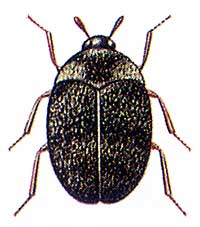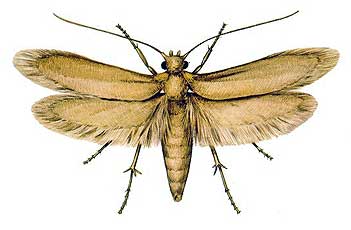
Textile Pests
Carpet Beetle
The Carpet Beetle is 2 to 4mm long, small, mottled brown, grey and
 cream. The related Fur Beetle is black with one spot on each wing
case, and there is an even more uncommon Black Carpet Beetle. The
larvae are small (about 4mm long), covered in brown hairs, and likely
to roll up when disturbed.
cream. The related Fur Beetle is black with one spot on each wing
case, and there is an even more uncommon Black Carpet Beetle. The
larvae are small (about 4mm long), covered in brown hairs, and likely
to roll up when disturbed.
The grubs of these small, oval beetles have replaced the clothes moths
as the main textile pest in the UK. Carpet beetle causes damage along
the seams of fabric where the grubs bite through the thread leaving
well-defined round holes.
Control:
Once the source of the infestation is identified it has to be removed.
The larvae can stray, so to eliminate an infestation a thorough examination
is essential.
Chemical sprays are used for spot treatment and insecticides to remove
infestations. Chemical treatments are only effective in conjunction
with proper cleaning.
Common Clothes Moth
All species of clothes moths are distinguished by folding their wings
like a tent along their backs. The adult Common Clothes Moth is 6 to 7mm
long with pale, plain golden-buff wings edged with hair. The less
common Case-Bearing Clothes Moth is duller and has three dark brown
spots on each of its wings.
tent along their backs. The adult Common Clothes Moth is 6 to 7mm
long with pale, plain golden-buff wings edged with hair. The less
common Case-Bearing Clothes Moth is duller and has three dark brown
spots on each of its wings.
Although the moths are harmless, their larvae cause damage to clothing
and other textiles, as they feed on fabrics produced from animals,
such as wool and fur.
Control:
The larvae can be difficult to spot, since they turn away from light.
However the damage they cause is much more obvious. Once discovered,
infested items should be removed and residual insecticides applied
to the surrounding area.
When treating textile moths the Exodus Ultra Low Volume System machine helps to flush out the insects from their harbourages, after the residual insecticide spray treatment has been carried out, enabling re-entry to the treated area after only one hour.
Contact us as our
expertise helps us to help you. Health and safety is paramount when
dealing with nuisance pests.
